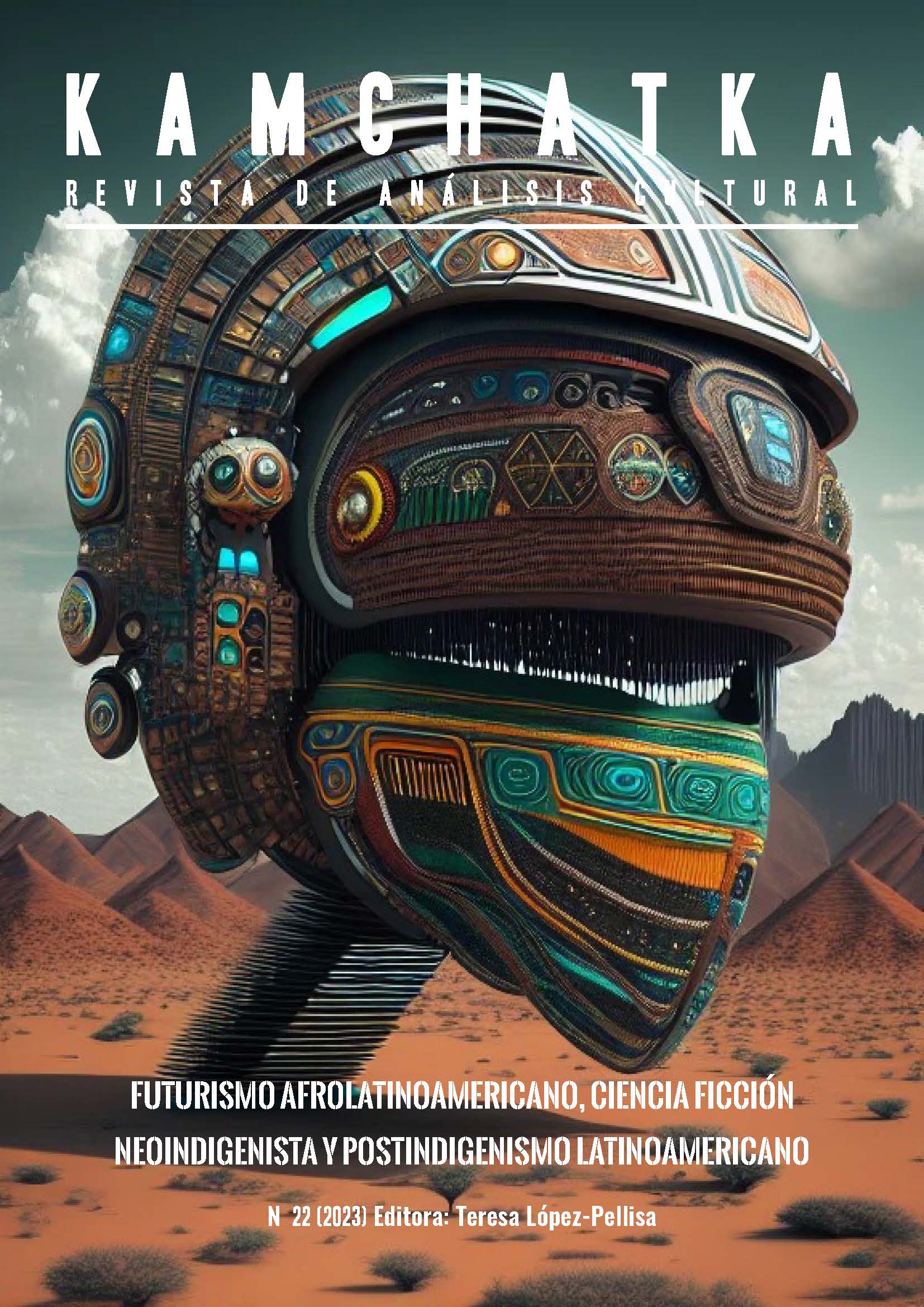Of Black Bodies and Celestial Bodies: Queer Afrofuturism and New Spatialities in Diego Paulino's Negrum3
DOI:
https://doi.org/10.7203/KAM.22.24235Keywords:
Brazilian Afrofuturism, Black cinema, Queer Utopia, Transgressive Utopianism Abstract
Abstract
This essay explores how Brazilian film director Diego Paulino performs activism through his short film Negrum3. I will argue that Negrum3 develops a new epistemology of the black and queer body using analogy and the appropriation of the language of astrophysics and science fiction in response to the current tense political climate and the homophobic policies of the Brazilian right. The different bodies that claim the cinematographic universe of this short film demonstrate a command of Afrofuturistic aesthetics and speculate about queer utopia and black futures. Consequently, the potentialities of the queer and black future that Paulino is presenting in his film are going to be framed within the aesthetic movement of Brazilian Afrofuturism. Moreover, two main theoretical ideas are going to anchor the analysis of the short film. First, I will discuss the film in relation to José Muñoz’s idea of queer utopia: “The future is queerness’s domain. Queerness is a structuring and educated mode of desiring that allows us to see and feel beyond the quagmire of the present.” (2009). Secondly, I will argue that Paulino is working with a new epistemological approach focused on the black queer body and by doing so, his work is aligned with Lucy Sargisson’s theoretical concept of “transgressive utopianism” (2000).
 Downloads
Downloads
 References
References
Andrade, Oswald de. “Manifesto Antropófago.” Do Pau-Brasil a ante das utopias. 6, (1972): 11-19.
Arenas, Fernando (2003). Utopias of otherness: nationhood and subjectivity in Portugal and Brazil. Minneapolis: University of Minnesota Press.
Brooks, Lonny Avi (2016). “Playing a Minority Forcaster in Search of Afrofuturism: Where am I in This Future, Stewart Brand?”. Anderson Reynaldo y Jones Charles E. (eds.). Afrofuturism 2.0 The Rise of Astro-Blackness. London: Lexington Books: 149-166.
Bulbul, Zózimo (1974). Alma no olho. Brazil: Zózimo Bulbul.
Colmon, Clayton D. “Queer Afrofuturism: Utopia, Sexuality, and Desire in Samuel Delany’s “Aye, and Gomorrah”.” Utopian Studies, 2 (2017): 327-346.
Coney, John (1974). Space is the Place. United States: Jim Newman.
Dery, Mark (1994). “Black to the future: interviews with Samuel R. Delany, Greg Tate, and Tricia Rose” Flame Wars: The Discourse of Cyberculture. Durham and London: Duke University Press.
Drygalska, Eva. “Space Is the Place: Black Cinema in Search of Speculative Fictions”. The Journal of Popular Culture, 4 (2019): 910-930.
Eshun, Kodwo. “Further Considerations on Afrofuturism.” CR: The New Centennial Review, 3.2 (2003): 287–302.
Freitas Kênia and José Messias. “O futuro será negro ou não será: Afrofuturismo versus Afropessimismo - as distopias do presente”. Revista de la Asociación Argentina de Estudios de Cine y Audiovisual, 17 (2018): 402-424.
Frye, David and Rama, Angel (2012). Writing across Cultures: Narrative Transculturation in Latin America. Durham: Duke University Press.
Freyre, Gilberto (1946). The Masters and the Slaves. Trans. Samuel Putnam. New York: Alfred A. Knopf.
Jones, Angela (2013). A Critical Inquiry into Queer Utopias. New York: Palgrave Macmillan.
Giorgi, Gabriel (2014). Formas comunes: Animalidad, cultura, biopolítica. Buenos Aires: Eterna Cadencia.
Halberstam, Jack (2011). The Queer Art of Failure. Durham: Duke University Press.
Kilgore, De Witt Douglas (2014). “Afrofuturism.” The Oxford Handbook of Science Fiction. Latham Rob (ed.). New York: Oxford University Press: 561-72.
Lavender III, Isiah, and Yaszek, Lisa (2020). Literary Afrofuturism in the Twenty-First Century. Chicago: Ohio State University Press.
Muñoz, José Esteban (2009) Cruising Utopia. New York: NYU Press.
Muñoz, José Esteban (1999). Disidentifications: Queers of Color and the Performance of Politics. Minneapolis: University of Minnesota Press.
Oliveira, Janaína. “With the Alma no Olho: Notes on Contemporary Black Cinema”. Film quarterly, 74-1 (2020): 32-38.
Oliveira, Valdina (2017). “Afro-Brazilian Religion, Resistance and Environmental Ethics A Perspective from Candomblé”. Harris Melanie (eds.). Ecowomanism, Religion and Ecology. Leiden: Brill.
Paulino, Diego (2018). Negrum3. Brazil: Reptilia Produçôes.
Pierce, Joseph M. “I Monster: Embodying Trans and Travesti Resistance in Latin America”. Latin American Research Review, 55 (2020): 305–321.
Preciado, Paul (2013). Testo junkie: sex, drugs, and biopolitics in the pharmacopornographic era. New York: The Feminist Press at the City University of New York.
Ríos, Felipe Luis, et al. “Axé, práticas corporais e Aids nas religiões africanistas do Recife, Brasil”. Temas Livres, 18 (2013): 3653-3651. https://doi.org/10.1590/S1413-81232013001200021
Rollefson, Griffith. “The Robot Voodoo Power Thesis: Afrofuturism and Anti-Anti-Essentialism from Sun Ra to Kool Keith”. Black Music Research Journal, 1 (2008): 83-109.
Sargisson, Lucy (2000). Utopian Bodies and the Politics of Transgression. London: Routledge.
Womack, Ytasha L (2013). Afrofuturism: The World of Black Sci-Fi and Fantasy Culture. Chicago: Lawrence Hill Books.
Yaszek, Lisa. “Race in Science Fiction: The Case of Afrofuturism and New Hollywood.” A Virtual Introduction to Science Fiction (2013).
Downloads
Published
How to Cite
-
Abstract691
-
Artículo PDF396
Issue
Section
License
This journal provides an immediate free access to the content on the principle that freely make investigation available to the public, which promotes an increased global knowledge exchange.
Unless otherwise indicated, texts published in this journal are under the license Attribution-NonComercial 4.0 by Creative Commons. These texts may be copied, distributed and publicly communicated whenever the publication’s author and title are quoted and whenever they are not used for commercial purposes. In any case, intellectual property of the articles and its potential economic rights entirely belong to its authors.
The full license can be consulted on https://creativecommons.org/licenses/by-nc/4.0/. We encourage authors to disseminate papers published in Kamchatka. Journal of cultural analysis electronically, in institutional digital repository or in their websites.





